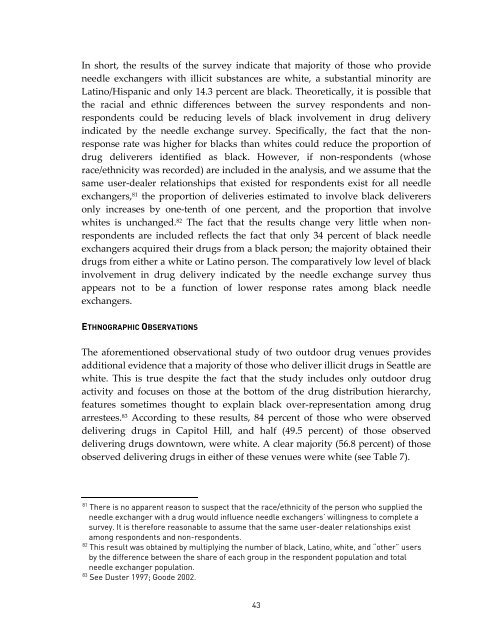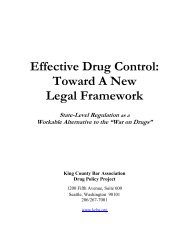RACE AND THE ENFORCEMENT OF DRUG DELIVERY LAWS IN ...
RACE AND THE ENFORCEMENT OF DRUG DELIVERY LAWS IN ...
RACE AND THE ENFORCEMENT OF DRUG DELIVERY LAWS IN ...
Create successful ePaper yourself
Turn your PDF publications into a flip-book with our unique Google optimized e-Paper software.
In short, the results of the survey indicate that majority of those who provide<br />
needle exchangers with illicit substances are white, a substantial minority are<br />
Latino/Hispanic and only 14.3 percent are black. Theoretically, it is possible that<br />
the racial and ethnic differences between the survey respondents and nonrespondents<br />
could be reducing levels of black involvement in drug delivery<br />
indicated by the needle exchange survey. Specifically, the fact that the nonresponse<br />
rate was higher for blacks than whites could reduce the proportion of<br />
drug deliverers identified as black. However, if non-respondents (whose<br />
race/ethnicity was recorded) are included in the analysis, and we assume that the<br />
same user-dealer relationships that existed for respondents exist for all needle<br />
exchangers, 81 the proportion of deliveries estimated to involve black deliverers<br />
only increases by one-tenth of one percent, and the proportion that involve<br />
whites is unchanged. 82 The fact that the results change very little when nonrespondents<br />
are included reflects the fact that only 34 percent of black needle<br />
exchangers acquired their drugs from a black person; the majority obtained their<br />
drugs from either a white or Latino person. The comparatively low level of black<br />
involvement in drug delivery indicated by the needle exchange survey thus<br />
appears not to be a function of lower response rates among black needle<br />
exchangers.<br />
ETHNOGRAPHIC OBSERVATIONS<br />
The aforementioned observational study of two outdoor drug venues provides<br />
additional evidence that a majority of those who deliver illicit drugs in Seattle are<br />
white. This is true despite the fact that the study includes only outdoor drug<br />
activity and focuses on those at the bottom of the drug distribution hierarchy,<br />
features sometimes thought to explain black over-representation among drug<br />
arrestees. 83 According to these results, 84 percent of those who were observed<br />
delivering drugs in Capitol Hill, and half (49.5 percent) of those observed<br />
delivering drugs downtown, were white. A clear majority (56.8 percent) of those<br />
observed delivering drugs in either of these venues were white (see Table 7).<br />
81 There is no apparent reason to suspect that the race/ethnicity of the person who supplied the<br />
needle exchanger with a drug would influence needle exchangers’ willingness to complete a<br />
survey. It is therefore reasonable to assume that the same user-dealer relationships exist<br />
among respondents and non-respondents.<br />
82 This result was obtained by multiplying the number of black, Latino, white, and “other” users<br />
by the difference between the share of each group in the respondent population and total<br />
needle exchanger population.<br />
83<br />
See Duster 1997; Goode 2002.<br />
43

















